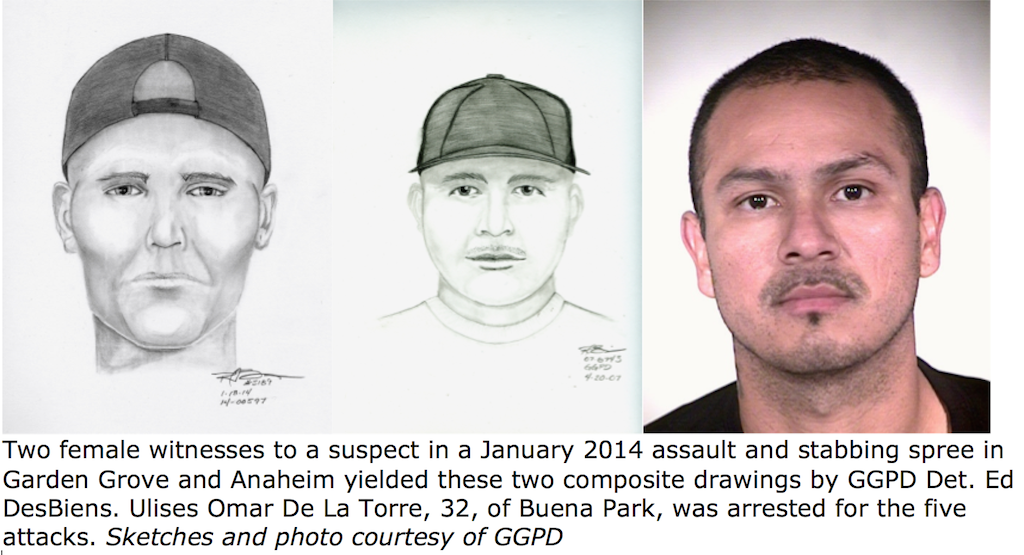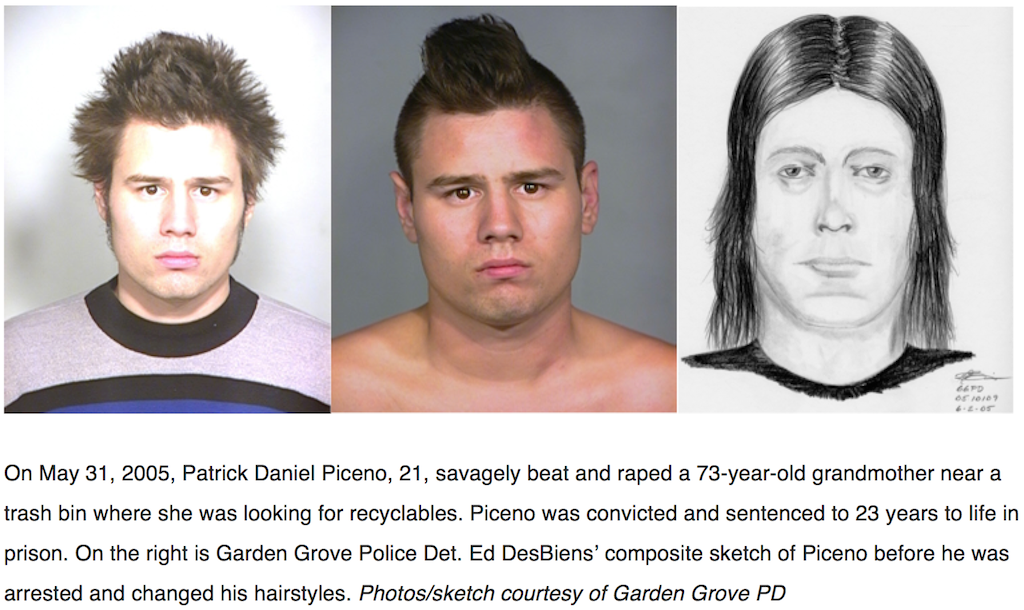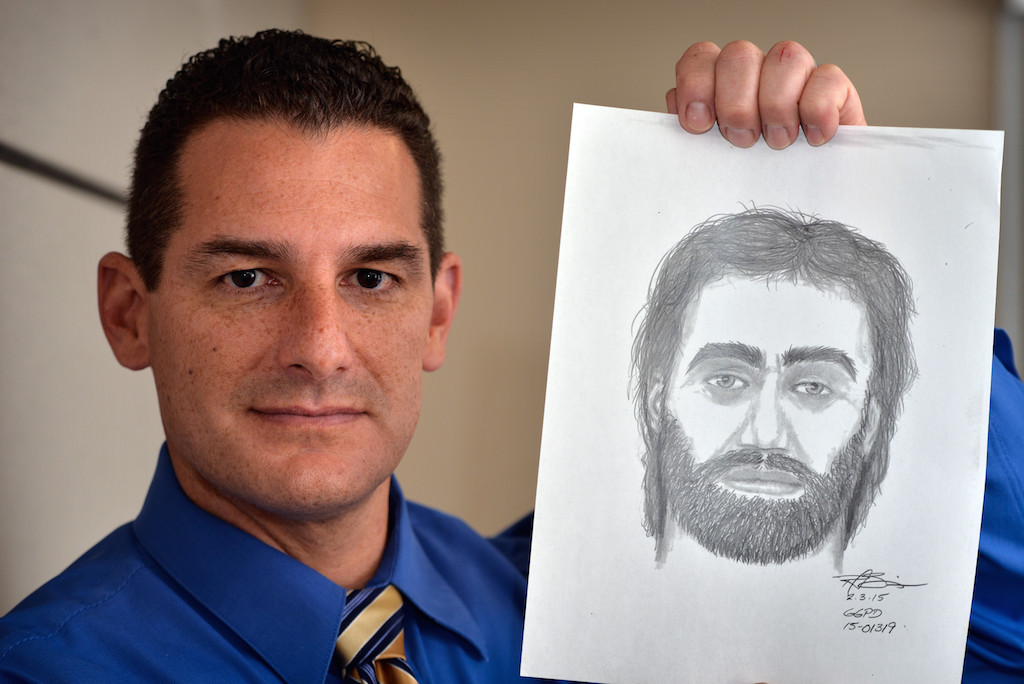He always starts with the eyes.
Pencil in hand, an electric eraser nearby to zap away fine detail if necessary, the composite artist goes to work.
Armed with details from a witness or victim — gleaned, often, from just a glimpse — he fleshes out the details using his preferred brand of pencil, a Staedtler Mars Lumograph, with a lead consistency varying from 3H to 8B.
Are the eyes deep set?
Squinty?
Unusually large?
He then moves on to the shape of the face.
Narrow or round?
Any distinctive markings?
He then sketches out the ears, chin, nose.
Cheeks, forehead, hair.
When he’s done with the drawing — when the witness or victim says it’s the best they can come up with, based on his or her memory — the black-and-white rendering merely is a likeness of the bad guy.
The drawing then is put on a flyer that is given to patrol officers and, often, distributed to other law enforcement agencies.
And the hunt for the perp goes on.
“It’s their drawing,” Garden Grove PD Det. Ed DesBiens says of the witnesses and victims he interviews, typically from two to four hours, before coming up with a drawing. “I let them direct how the drawing turns out. I don’t impose my own style on it.
“I always like to tell them, ‘You’re going to be drawing this picture — I just happen to be the pencil. Just tell me what you want, and I’ll put it on paper.’”
DesBiens, 45, works as a domestic violence detective in the GGPD’s Crimes Against Persons unit.
The 23-year agency veteran also doubles as the GGPD’s composite artist. His skills sometimes are tapped by neighboring police departments that don’t have one of their own.
DesBiens has been drawing professionally since 2004. He is certified as a composite artist by POST (Police Officer Standards and Training), which gives him added credibility in court when he’s asked to testify as an expert composite artist.
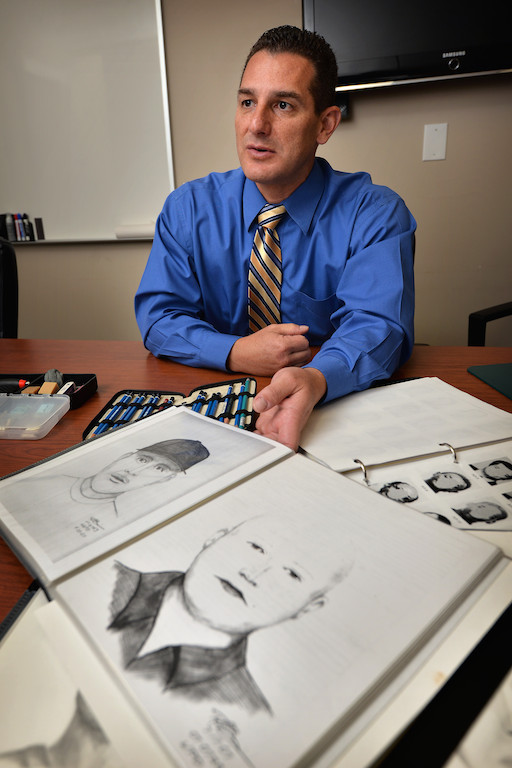
Garden Grove Police Det. Ed DesBiens shows a collection of some of sketches he has done for the police department and from the classes he took to become a police composite artist.
Photo by Steven Georges/Behind the Badge OC
His craft has helped put bad guys away.
His most recent composite drawing for a major crime was back in January 2014, when a man attacked five women, stabbing some, in Garden Grove and Anaheim.
DesBiens’ composite drawing was based on an interview with the fourth victim, who ran past the attacker in the evening and only caught a glimpse of him.
Ulises Omar De La Torre, 32, of Buena Park, eventually was arrested on suspicion of attempted murder, assault with a deadly weapon and assault with intent to commit mayhem or rape.
The criminal case against De La Torre is pending.
“I’m only as good as my witnesses,” DesBiens says of his drawings.
In another notable case, DesBiens’ two composite drawings (based on two witnesses) helped lead to the arrest of a gang member who fatally shot a man walking with his three brothers in April 2007.
The killer, Freddy Rodriguez, mistook the victim, Martin Aquino, 20, as a gang member. Rodriguez was convicted of first-degree murder and is serving life without the possibility of parole plus 30 years for firing a single bullet to Aquino’s heart.
In another case, DesBiens drew an uncanny composite of a man who viciously beat and raped an elderly Asian woman and left her to die next to a Dumpster.
The witness worked in a donut shop across the street from the attack and briefly saw him from 40 to 50 feet away.
The composite was seen by a friend of the suspect who told cops, “Oh my God! I know who that is; that’s my friend.”
For that May 31, 2005 attack, Patrick Daniel Piceno, 21 at the time, is serving 23 years to life in prison.
DesBiens, who mostly grew up in Garden Grove, started doodling in grade school.
He took an art class in junior high, devoured the comics section of the newspaper, but never aspired to be a cartoonist or artist.
Instead, DesBiens (his father is French Canadian, and each ‘s’ in his last name is silent) wanted to become a cop, inspired by a police officer who spoke to his kindergarten class and took a picture of DesBiens in his patrol car.
“My mom and dad laughed when I told them I wanted to be a cop,” he recalls.
DesBiens became an explorer with the GGPD while a sophomore in high school.

Det. Ed DesBiens says of the art of composite drawing:”It’s all about technique.”
Photo by Steven Georges/Behind the Badge OC
On one assignment, he and his partner went door to door showing a composite drawing of a female suspected of kidnapping an infant from a daycare center on the west side of the city.
“That lady lives across the street,” one resident told a young DesBiens as he displayed the flyer.
Cops found the child unharmed in the attic of the home.
“He did an incredible job with the composite,” DesBiens said of the artist.
After graduating from high school, DesBiens went to college to earn his AA in criminal justice and became a cadet.
The GGPD picked him up as a recruit, and DesBiens graduated from the Orange County Sheriff’s Regional Training Academy in January 1992 — one of only 11 to graduate from the original class of 36.
The art of composite drawing can be taught, DesBiens said.
“It’s all about technique,” the detective said. “I didn’t know how to ride motorcycles before, but they (GGPD) showed me the technique, and I became a motor officer.”
DesBiens credits his instructors at Stuart Parks Forensics Associates in Cataldo, Idaho, with honing his skills.
At the Garden Grove PD, he’s served on a variety on units: motors, K-9, patrol. When he was a motorcycle officer, he was cut off on the 55 Freeway. He suffered a compound fracture of his left leg but was back on his bike in eight months.
DesBiens has been working DV cases since 2014.
For the past 17 years, he also has served as a Reservist in the U.S. Navy.
DesBiens now is a Senior Chief Petty Officer (rank E8), one of the highest-ranking enlisted positions (only one, Master Chief, at E9, is higher).
Once a month, DesBiens works in San Diego as the Senior Enlisted Leader of the Command Third Fleet, Joint Force Maritime Component Commander.
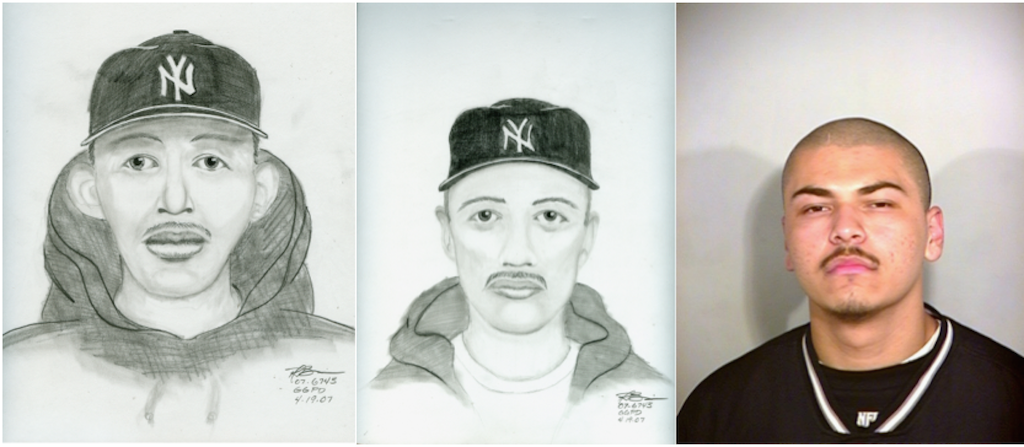
Two witnesses to a shooting in 2007 got only brief glimpses of the suspect. DesBiens drew these two composites based on their descriptions. The suspect, Freddy Rodriguez, was arrested and convicted of the murder. Sketches and photo courtesy of the Garden Grove PD.
“I always wanted to serve my country, and I always gravitated to the Navy,” said DesBiens, whose father worked at the Long Beach Naval Shipyard.
DesBiens, who is married with three boys, to date has completed about three dozen composite drawings for the GGPD, Westminster PD, the Irvine PD and Costa Mesa PD.
“I really like being able to sit down with somebody and try to come up with as accurate a rendering as possible,” DesBiens said. “All the time I tell people, ‘Don’t be afraid to tell me that we need to erase something.’”
How does he know when he’s done with a drawing?
“I will ask them (witnesses) to grade, on a scale of 1 to 10, my drawing,” DesBiens said. “Typically they will say 6 or 7.
“Then I will ask them, ‘OK , what can I do to make this better?’”
Usually he will tweak a drawing – maybe add some more shading.
“It’s funny, sometimes I will go just a fraction of a hair wider on a nose, and they will say, ‘That’s it!’”
Adds DesBiens: “It’s like putting pieces of a puzzle for me. I love doing this.”
 Behind the Badge
Behind the Badge

